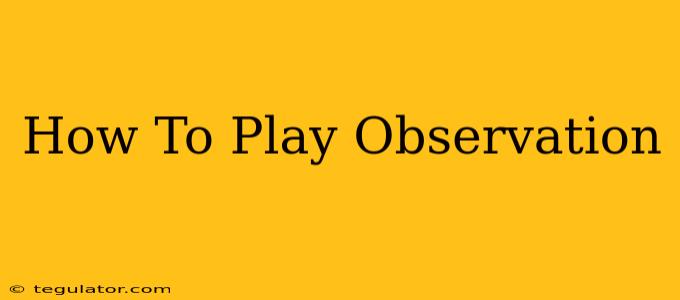Observation is a first-person puzzle game that challenges players to solve mysteries aboard a derelict space station. Unlike typical puzzle games, Observation relies heavily on manipulating the environment and using different tools to uncover clues and progress. This guide will help you understand the core mechanics and offer tips for conquering the challenges within.
Understanding the Core Mechanics of Observation
The game revolves around your role as Dr. Emma Fisher, an AI inhabiting the space station's systems. You don't directly control Emma physically; instead, you control the station's various systems and tools to solve puzzles. These include:
The Camera System:
- Panning and Zooming: Essential for exploring the environment and finding hidden clues. Pay close attention to detail; small objects and seemingly insignificant markings often hold vital information.
- Recording and Playback: Use this feature to capture important events, examine them closely, and potentially discover patterns or clues you missed.
The Station's Systems:
- Power Management: Some areas of the station require power to function. Learning how to route power and manage the station's energy is crucial.
- Environmental Controls: You'll need to manipulate systems controlling lights, doors, pressure, and other aspects of the environment to solve puzzles.
- Internal Communications: Listen to audio logs and communications to gather vital information and backstory.
Dr. Emma Fisher's Abilities:
- Access to System Logs: Explore the station's system logs for clues. These often contain cryptic messages or technical data.
- Limited Interaction: While you control the systems, you have limited direct interaction with the physical environment. You will need to think creatively to overcome obstacles.
Solving Puzzles in Observation
Observation's puzzles are interconnected and require careful observation and logical deduction. Here's a breakdown of effective puzzle-solving strategies:
1. Thorough Exploration:
- Systematic Search: Don't rush. Methodically explore each area, using the cameras to examine every corner.
- Focus on Details: Look closely at objects, screens, and markings. Hints are often subtly hidden.
2. Utilizing the Tools:
- Strategic Camera Placement: Positioning cameras strategically allows you to observe multiple areas simultaneously.
- Combining System Controls: Many puzzles require the combined use of various systems. Think about how different systems might interact.
3. Deductive Reasoning:
- Connecting Clues: Pay attention to how clues relate to each other. Often, the solution involves piecing together multiple pieces of information.
- Logical Inference: Use your intuition and logical thinking to form hypotheses and test them.
Tips for a Smoother Gameplay Experience
- Take Notes: Keep a notepad handy to jot down important clues, observations, and potential solutions.
- Experiment: Don't be afraid to try different approaches. Failure is often a learning opportunity.
- Listen Carefully: Audio logs and communications provide crucial context and clues.
Mastering Observation: A Rewarding Challenge
Observation is a truly unique and engaging puzzle game that rewards careful observation, logical thinking, and creative problem-solving. By understanding the mechanics, employing strategic approaches, and utilizing the tools at your disposal, you'll be well on your way to mastering this challenging and rewarding experience. Good luck, Dr. Fisher!

